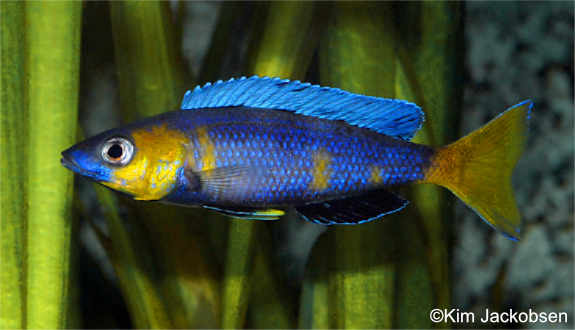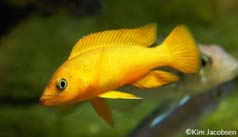

Alternative species (click on the thumbnail to see the card)
Names
Scientific name
Cyprichromis leptosoma
Limnochromis leptosoma
Paratilapia leptosom
Common name
Slender cichlid
Black-finned Slender Cichlid
Malasa Leptosoma
Neonback
Utinta Fluorescent
Blue Flash
Blue Neon
Neon Head
Origin

Origin: Africa (Lake Tanganyika)
Biotope: African
Dimorphism

The male is larger and more colorful than the female
Group

Cichlidae
Volume

450 L / 100 Imp gal / 120 Us gal
Parameters

T°: 25 à 26°C or 77 to 79°F
pH: 8 to 8.5
Hardness: 14 to 18°dGH
Difficulty

Average
Size

10 to 12 cm (4 to 4.8")
Longevity

5 to 7 years
Living zone
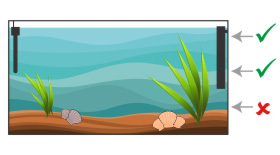
Top and middle
Individuals

8
Food
How to feed the Cyprichromis leptosoma?
Food
How to feed the Cyprichromis leptosoma?
In the wild, these fish feed on plankton that they capture thanks to the particular shape of their mouths. In captivity, you can give them live or frozen prey. On the menu: cyclops, daphnia, copepods (avoid worms and larvae because they are too rich in animal proteins)... You can also give them from time to time flakes that float on the surface.
Distribute two small meals a day rather than one large one.
Behavior
What kind of behavior does the Cyprichromis leptosoma have?
Behavior
What kind of behavior does the Cyprichromis leptosoma have?
Unlike many bottom-dwelling species, this fish prefers to live in the open water, which makes them good candidates to occupy the upper part of an African aquarium.
Sociable, it likes to live in schools. It is an excellent swimmer, quite lively. The male is always on the move to defend his territory or to find a pregnant female.
Cohabitation
Who can live with the Cyprichromis leptosoma?
Cohabitation
Who can live with the Cyprichromis leptosoma?
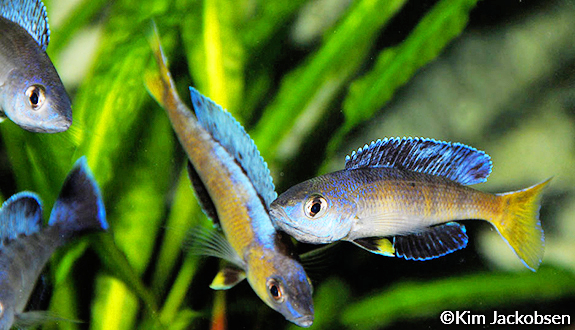
The presence of its fellow creatures is essential to its well-being. Thus, constitute a group of at least 8 specimens for an aquarium of 450 L / 100 Imp gal / 120 Us gal (150 cm or 60" of frontage, height of at least 50 cm or 20"). Several males can be associated provided that the females remain in higher numbers. In general, 1 male for 3 females is recommended because the males are ardent Romeo (they constantly solicit the females to reproduce). One can thus make 2 males and 5 to 6 females for an aquarium of 450 L / 100 Imp gal / 120 Us gal.
Cohabitation with other species is facilitated by the fact that the Cyprichromis leptosoma lives in the upper half of the aquarium. Thus, it can be associated with other species of Tanganyika as the Julidochromis or Neolamprologus similis.
Avoid associating it with Frontosa, which are its natural predators. Beware also of the risk of hybridization with other species of Cyprichromis and Paracyprichromis.
Breeding
How to breed the Cyprichromis leptosoma?
Breeding
How to breed the Cyprichromis leptosoma?
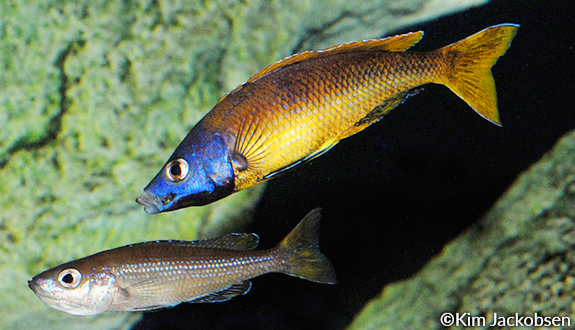
It is quite easy to breed this species. Spawning takes place in open water and the released eggs fall to the ground. The female then collects them in their fall to place them in her mouth. Indeed, this fish is a maternal mouth incubator. The eggs are quite big but not round! The female also absorbs the male's milt, fertilizing the eggs. Incubation lasts between 3 and 4 weeks, during which time the female stops feeding.
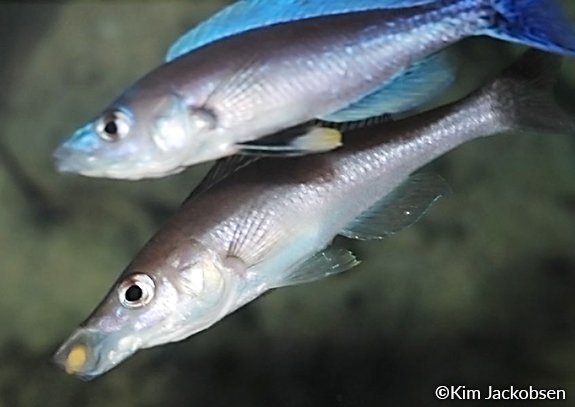
The young are few in number (20 maximum per clutch) but their chance of survival is increased by their size when they are spat out of the female's mouth. They measure then almost one centimeter. The fry, if they are not in the presence of predators, then evolve in schools near the surface. Note that a female should never be forced to spit out her young because the female is fragile and does not like to be handled at all.
They grow regularly until they take the colors of their sex, at 6-7 months. Sexual maturity is reached at 1 year.
Of course, in a general aquarium, it will be necessary to protect them from the voracity of the occupants and to isolate them in aquariums of magnification.
Fry feeding: Artemia nauplia then larger live prey (Grindal worms and Cyclops). Distribute small meals at least 3 times a day.
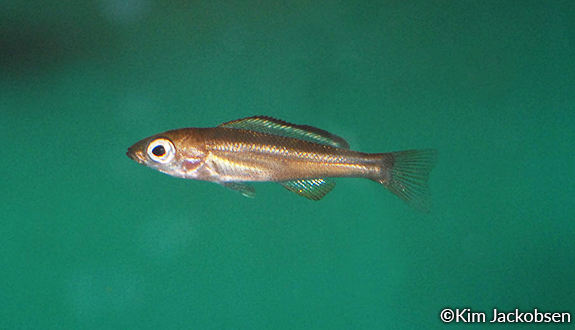
Its aquarium
Which aquarium for the Cyprichromis leptosoma?
Its aquarium
Which aquarium for the Cyprichromis leptosoma?
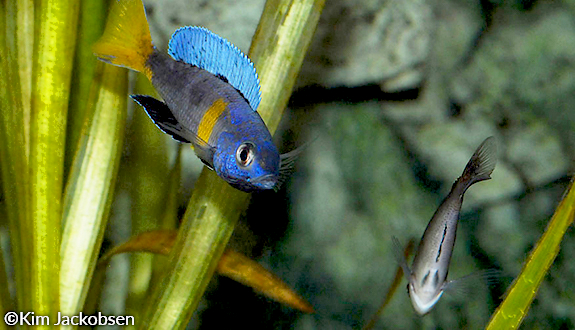
This good swimmer needs room to exercise. Therefore, the decor will be more suitable if he concentrates on the back part of the aquarium. It can be formed by large vertical stones and piles of rocks forming cavities (pay attention to the stability of your decor). The floor can be made of fine sand.
Large plants such as Cryptocoryne usteriana, Vallisneria gigantea, Anubias barteri, Ceratophyllum demersum can also be useful to the females to hide and to the males to delimit their territories.
On the water quality side, make sure that the nitrate level remains as low as possible. To do this, make regular water changes. The species also appreciates a good level of oxygen, which you can obtain by choosing a rather powerful filtration and by creating eddies on the surface.
Good To know
Find all additional information!
Good To know
Find all additional information!
Depending on its geographical origin, the coloration of Cyprichromis may vary. Thus, there are many varieties not always easy to identify and sometimes confused. To avoid hybridization of its varieties, ask specifically about the origin of the specimens you want to acquire. One can note these some names (non-exhaustive list:
Cyprichromis leptosoma Livua Blue orchid
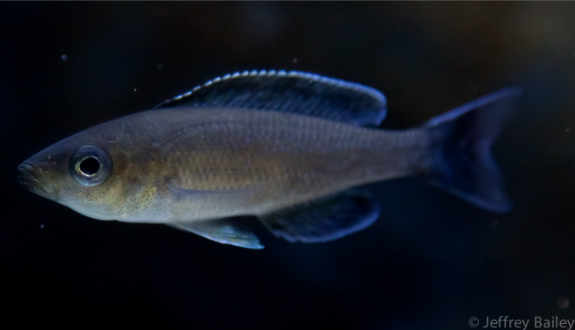
Cyprichromis leptosoma Kitumba
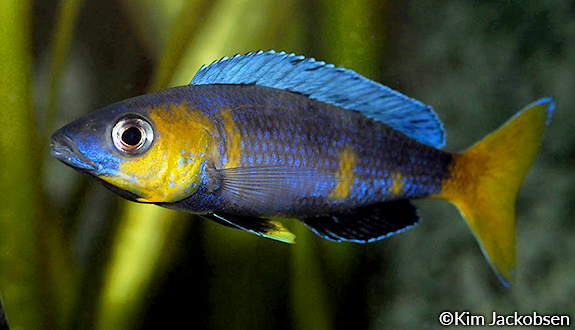
Cyprichromis leptosoma Kitumba
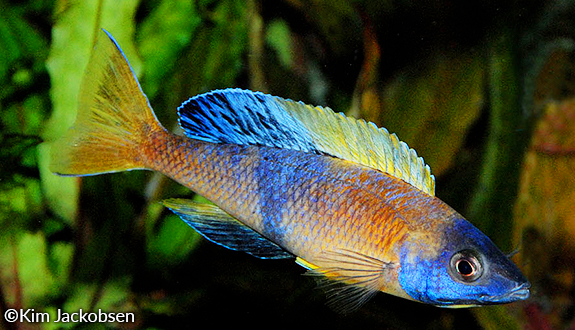
Cyprichromis leptosoma jumbo Kitumba
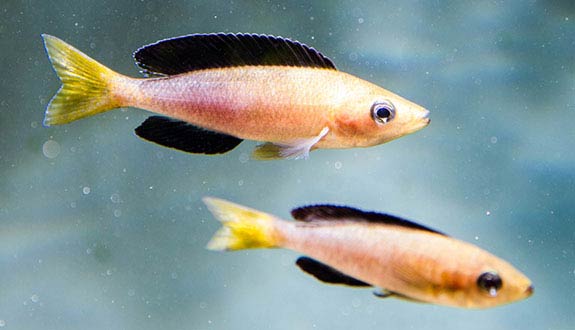
Cyprichromis leptosoma Chituta (or Neon Head)
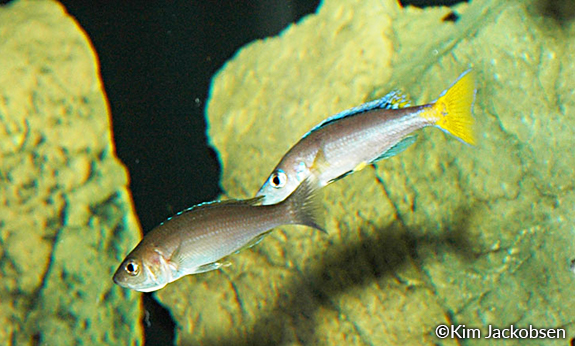
Cyprichromis leptosoma Bulu point
Cyprichromis leptosoma Chipimbi
Cyprichromis leptosoma Kalambo
Cyprichromis leptosoma Karilani
Cyprichromis leptosoma Kigoma
Cyprichromis leptosoma Kigoma albino
Cyprichromis leptosoma Katete
Cyprichromis leptosoma Nkondwe
Cyprichromis leptosoma Mbity
Cyprichromis leptosoma Moba
Cyprichromis leptosoma Malassa (or Malasa)
Cyprichromis leptosoma Mpimbwe
Cyprichromis leptosoma Mpulungu (or Blue Flash)
Cyprichromis leptosoma Mvuna
Cyprichromis leptosoma Utinta
Yours photos!

By Encyclo-Caro

By Encyclo-Caro

By Encyclo-Caro

By Encyclo-Caro

By Encyclo-Caro
Comments
Sort by:
Please login to post comments
